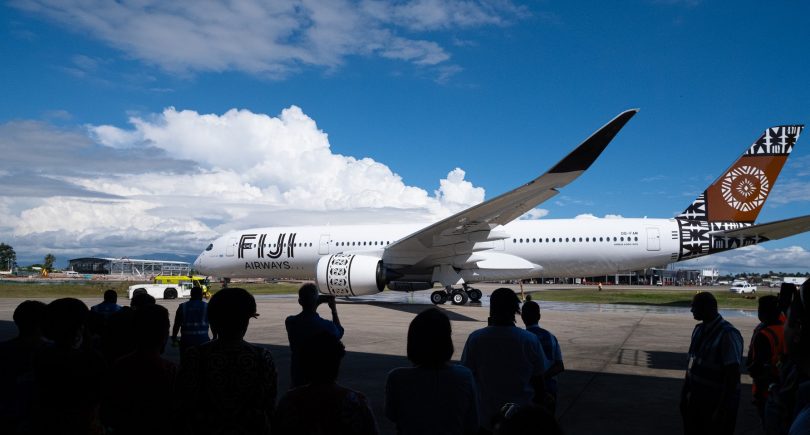The spike in migration out of Fiji since the end of COVID has been widely commented on. It is certainly real. As the graph below shows, prior to 2018 there were on average about 9,000 more departures than arrivals of Fijian residents every year. There were more than 25,000 in each of 2018 and 2019, then, after a COVID pause, more than 40,000 in each of 2022 and 2023.

Fiji’s population is just under one million. A net out-migration rate of 5%, the 2023 level, is high by any standards.
A key question is whether this is a temporary spike or a new trend. A recent ANZ study put the case for its being temporary. With Australia and New Zealand both tightening their migration policies, the ANZ argues that out-migration from Fiji will fall. We are not so sure.
Australia and New Zealand are the two main destination countries for Fijian migrants, with the diaspora in these two countries constituting more than 60% of the total Fijian diaspora according to UN data. There has been no trend upwards in the number of Fijians becoming permanent residents in either Australia or New Zealand, the two main destination countries. (Though there was a spike in New Zealand due to its new resident visa, introduced in 2021, which offered temporary residents a pathway to permanent residency.)

This means that the migration boom must have been in people exiting Fiji on temporary rather than permanent visas. At first sight, this fact supports the proposition that the boom itself is temporary rather than permanent. However, a closer look tells a different story.
There are four main groups of Fijian temporary migrants in Australia and New Zealand: temporary workers under the Pacific Australia Labour Mobility (PALM) and Recognised Seasonal Employer (RSE) schemes respectively, asylum-seekers, students and workers.

Notes: Figures reflect the year-end population level. “Fijians” refers to people with Fiji citizenship.
The first group, of PALM workers, will mainly return to Fiji. The second group, unique to Australia, is of bridging visa holders. Fijians have been a leading source country for asylum applications in recent years. The bridging visas obtained while the application is being processed act as multi-year work visas. Most applications are rejected, so this group too will eventually return. That leaves the workers under other temporary migration programs, and students.
Temporary non-PALM Fijian workers in Australia grew from 713 in 2019 to 2,624 in 2023. The number of students grew from 668 to 4,636 over the same period.
Growth in Fijian students and temporary non-RSE workers in New Zealand has been more modest, but still positive. The numbers of students grew from 1,962 in 2019 to 2,556 in 2023. The number of temporary non-RSE workers grew from 5,658 to 8,199. This is despite the new resident visa mentioned earlier. Over 10,000 Fijians obtained NZ residency through this new visa in 2022 and 2023, and 94% of them were granted onshore, largely clearing the stock of temporary Fijian migrants. But a large wave of new arrivals of Fijian non-seasonal workers meant that the number of non-RSE temporary workers nevertheless reached a new peak in 2023.
Most students in New Zealand are the dependents of Fijian temporary workers: 90% at the end of 2023. This is not the case in Australia. Whereas in New Zealand there are three times as many temporary workers as students, in Australia there are many more students than temporary workers.
The increase in Fijian students in Australia has come in the vocational education and training (VET) sector, where the number of student visa holders has exploded from 400 pre-COVID to close to 4,000 currently.
As the figure below shows, total VET applications have recovered to pre-COVID levels but applications from Fiji, even though they have fallen over the last year, are close to ten times their pre-COVID level.

Total VET visa grants to all students are now below pre-COVID levels, following a tightening of requirements by Australia. However, grants to Fijians, though half their post-pandemic high, are still five times pre-pandemic levels.
Australian student visa fees are being hiked, but an exemption has been promised for the Pacific. The new requirement that student visas can only be applied for off-shore will surely dent the number of Fijian students able to stay in Australia long-term. Nevertheless, many students and temporary workers will be determined to stay on in Australia. A lower share might succeed but it will be a lower share of a much bigger group.
No one can be sure what the flow of out-migration from Fiji will look like in future years. An out-migration rate of 5% is unlikely to be sustained. Perhaps there will be a drop down to the pre-COVID level of around 25,000 residents leaving each year. However, given the trends and types of migration that we are observing, we expect out-migration to remain strong.
Disclosure
This research was supported by the Pacific Research Program, with funding from the Department of Foreign Affairs and Trade. The views are those of the authors only.


Leave a Comment